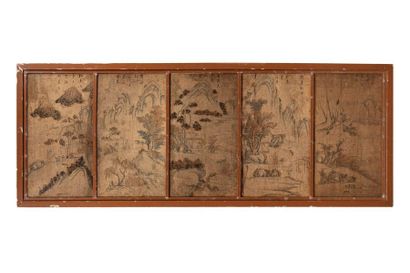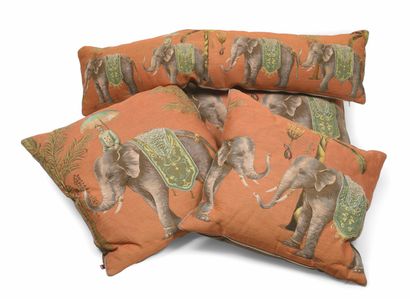Suite de cinq personnages en porcelaine issus du ballet 'Le Carnaval' des Ballets Russes, circa 1914-1923 A set of five Meissen figures from the Ballets Russes in the ballet 'Le Carnaval', circa 1914-1923Modelled by Paul Scheurich depicting Pierrot, Eusebius, Estrella, Chiarina, Harlequin and Columbine, 18.4cm, 23.5cm, 27.3cm, 26.7cm, 28cm, crossed swords marks in underglaze-blue, incised model numbers D 283-D 287, impressed Bossierer numbers 156, 50, 123, 150, 85, painters' numbers 27, 27, 15, 12, 67 (miniscule chip to edge of ruffle on Chiarina) (5)FootnotesExhibited: Meissen, Museum der Meissen Porzellan-Stiftung, Paul Scheurich Porzellangestalter Zeichner Grafiker, 6 March 2020-21 February 2021 Paul Scheurich's first models for the Meissen factory were those based on characters from the ballet "Le Carnaval", which was performed several times by Sergei Diaghilev's Ballets Russes between 1910 and 1912 in Berlin. Diaghilev's company and their performances sparked excitement across Europe in the early 1910s and many great names in music and modern art worked with them throughout the next 20 years, such as Ravel, Debussy, Strauss, Picasso and Braque. The ballet "Le Carnaval" was first arranged by Michael Fokin for a charity ball in Saint Petersburg in 1910 to Robert Schumann's piano music of the same name. Due to its success, Diaghilev decided to take his company to Paris, and it was on the way there that they performed in Berlin for the first time on 24 May 1910. Their visit was only short and it wasn't until their return in January 1912 that they were widely celebrated and greeted with big enthusiasm by the press and Berlin audience. On 8 January 1912, opening night, the Berliner Tagesblatt published an interview with Diaghilev on their front page with a review following the next day: 'Die Freunde und Kenner wahrer Tanzkunst hatten gestern einen genußreichen Abend. ...' [The friends and connoisseurs of the art of dance had yesterday a highly enjoyable evening ...]. Due to his profound interest in theatre and music, it is likely that Scheurich went to see the ballet during their highly-publicised performances of 1912. In the same year Scheurich worked with the publishers Fritz Gurlitt, Berlin, who published a folder of illustrations with the title 'Pierrot' (see lot 8), depicting Commedia dell'Arte figures in daily life which resemble the figures from 'Le Carnaval' (Rafael 1995c, p. 59-60 and fig. 5), suggesting that he created the porcelain models in the same year and no earlier. Early drawings and photographs of the dancers show how the porcelain models are definite renditions of the characters in the ballet, incorporating many of the original costume designs by Leon Bakst. Scheurich first brought the models to the factory at the end of 1912 and they were purchased for their production by Max Adolf Pfeiffer in June 1913 for 2500 Marks. Scheurich's decoration suggestions followed in January 1914 and the first completed figures were ready in February of the same year (Rafael 1995a, p.22). For a detailed discussion of Scheurich's ballet models, see Rafael 1995c.
Suite de cinq personnages en porcelaine issus du ballet 'Le Carnaval' des Ballets Russes, circa 1914-1923 A set of five Meissen figures from the Ballets Russes in the ballet 'Le Carnaval', circa 1914-1923Modelled by Paul Scheurich depicting Pierrot, Eusebius, Estrella, Chiarina, Harlequin and Columbine, 18.4cm, 23.5cm, 27.3cm, 26.7cm, 28cm, crossed swords marks in underglaze-blue, incised model numbers D 283-D 287, impressed Bossierer numbers 156, 50, 123, 150, 85, painters' numbers 27, 27, 15, 12, 67 (miniscule chip to edge of ruffle on Chiarina) (5)FootnotesExhibited: Meissen, Museum der Meissen Porzellan-Stiftung, Paul Scheurich Porzellangestalter Zeichner Grafiker, 6 March 2020-21 February 2021 Paul Scheurich's first models for the Meissen factory were those based on characters from the ballet "Le Carnaval", which was performed several times by Sergei Diaghilev's Ballets Russes between 1910 and 1912 in Berlin. Diaghilev's company and their performances sparked excitement across Europe in the early 1910s and many great names in music and modern art worked with them throughout the next 20 years, such as Ravel, Debussy, Strauss, Picasso and Braque. The ballet "Le Carnaval" was first arranged by Michael Fokin for a charity ball in Saint Petersburg in 1910 to Robert Schumann's piano music of the same name. Due to its success, Diaghilev decided to take his company to Paris, and it was on the way there that they performed in Berlin for the first time on 24 May 1910. Their visit was only short and it wasn't until their return in January 1912 that they were widely celebrated and greeted with big enthusiasm by the press and Berlin audience. On 8 January 1912, opening night, the Berliner Tagesblatt published an interview with Diaghilev on their front page with a review following the next day: 'Die Freunde und Kenner wahrer Tanzkunst hatten gestern einen genußreichen Abend. ...' [The friends and connoisseurs of the art of dance had yesterday a highly enjoyable evening ...]. Due to his profound interest in theatre and music, it is likely that Scheurich went to see the ballet during their highly-publicised performances of 1912. In the same year Scheurich worked with the publishers Fritz Gurlitt, Berlin, who published a folder of illustrations with the title 'Pierrot' (see lot 8), depicting Commedia dell'Arte figures in daily life which resemble the figures from 'Le Carnaval' (Rafael 1995c, p. 59-60 and fig. 5), suggesting that he created the porcelain models in the same year and no earlier. Early drawings and photographs of the dancers show how the porcelain models are definite renditions of the characters in the ballet, incorporating many of the original costume designs by Leon Bakst. Scheurich first brought the models to the factory at the end of 1912 and they were purchased for their production by Max Adolf Pfeiffer in June 1913 for 2500 Marks. Scheurich's decoration suggestions followed in January 1914 and the first completed figures were ready in February of the same year (Rafael 1995a, p.22). For a detailed discussion of Scheurich's ballet models, see Rafael 1995c.










.jpg)



Try LotSearch and its premium features for 7 days - without any costs!
Be notified automatically about new items in upcoming auctions.
Create an alert